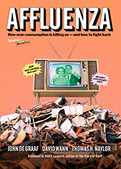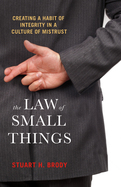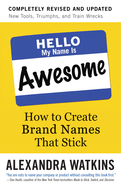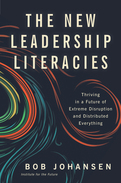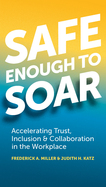Search Results: "Unequal protection"
Results 49-53 of 53
Affluenza
2014
NEW EDITION, REVISED AND UPDATED
affluenza, n. a painful, contagious, socially transmitted condition of overload, debt, anxiety, and waste resulting from the dogged pursuit of more.
We tried to warn you! The 2008 economic collapse proved how resilient and dangerous affluenza can be. Now in its third edition, this book can safely be called prophetic in showing how problems ranging from loneliness, endless working hours, and family conflict to rising debt, environmental pollution, and rampant commercialism are all symptoms of this global plague.
The new edition traces the role overconsumption played in the Great Recession, discusses new ways to measure social health and success (such as the Gross Domestic Happiness index), and offers policy recommendations to make our society more simplicity-friendly. The underlying message isn't to stop buying—it's to remember, always, that the best things in life aren't things.
affluenza, n. a painful, contagious, socially transmitted condition of overload, debt, anxiety, and waste resulting from the dogged pursuit of more.
We tried to warn you! The 2008 economic collapse proved how resilient and dangerous affluenza can be. Now in its third edition, this book can safely be called prophetic in showing how problems ranging from loneliness, endless working hours, and family conflict to rising debt, environmental pollution, and rampant commercialism are all symptoms of this global plague.
The new edition traces the role overconsumption played in the Great Recession, discusses new ways to measure social health and success (such as the Gross Domestic Happiness index), and offers policy recommendations to make our society more simplicity-friendly. The underlying message isn't to stop buying—it's to remember, always, that the best things in life aren't things.
affluenza, n. a painful, contagious, virally transmitted condition of overload, debt, anxiety, and waste resulting from the dogged pursuit of more.
We are living in a time when dishonesty and duplicity are common in our public institutions, our workplaces, and even in our personal relationships. But by recognizing and resisting the small, seemingly inconsequential ways we make moral compromises in our own lives, we can repair the tear in our social and moral fabric.
The Law of Small Things begins with an IQ (Integrity Quotient) test designed to reveal the casual way we regard our promises and the misconceptions we have about acting truthfully. The book shows how most people believe that integrity is something we “just have” and that we just do, like a Nike commercial. It depicts these and other deceptions we deploy to appear to act with integrity without actually doing so.
The Law of Small Things also exposes how our culture encourages breaches of integrity through an array of “permitted promise-breaking,” a language of clichés that equates self-interest with duty, and the “illusion of inconsequence” that excuses small breaches with the breezy confidence that we can fulfill integrity when it counts.
Brody challenges the prevailing notion that integrity is a possession you hold permanently. No one “has integrity” and no one is perfect in practicing it. What we have is the opportunity to uphold promises and fulfill duties in each situation that faces us, large and small. Integrity is a practice and a habit of keeping promises, the ones we make explicitly and the ones that are implied in all our relationships.
Ultimately, developing skill in the practice of integrity leads us to knowledge of who we are--not in the way the culture defines us, but in the way we truly know ourselves to be.
The Law of Small Things begins with an IQ (Integrity Quotient) test designed to reveal the casual way we regard our promises and the misconceptions we have about acting truthfully. The book shows how most people believe that integrity is something we “just have” and that we just do, like a Nike commercial. It depicts these and other deceptions we deploy to appear to act with integrity without actually doing so.
The Law of Small Things also exposes how our culture encourages breaches of integrity through an array of “permitted promise-breaking,” a language of clichés that equates self-interest with duty, and the “illusion of inconsequence” that excuses small breaches with the breezy confidence that we can fulfill integrity when it counts.
Brody challenges the prevailing notion that integrity is a possession you hold permanently. No one “has integrity” and no one is perfect in practicing it. What we have is the opportunity to uphold promises and fulfill duties in each situation that faces us, large and small. Integrity is a practice and a habit of keeping promises, the ones we make explicitly and the ones that are implied in all our relationships.
Ultimately, developing skill in the practice of integrity leads us to knowledge of who we are--not in the way the culture defines us, but in the way we truly know ourselves to be.
The ultimate guide to naming your product or business has been updated throughout with twice as many resources as before, new stories (of both hits and flops), and an entirely new chapter on the power of names in the workplace.
Too many new companies and products have names that look like the results of a drunken Scrabble game (Xobni, Svbtle, Doostang). In this entertaining and engaging book, ace-naming consultant Alexandra Watkins explains how anyone—even noncreative types—can create memorable and effective brand names. No degree in linguistics required.
The heart of the book is Watkins's proven SMILE and SCRATCH Test. A great name makes you SMILE because it is Suggestive—evokes something about your brand; is Memorable—makes an association with the familiar; uses Imagery—aids memory through evocative visuals; has Legs—lends itself to a theme for extended mileage; and is Emotional—moves people.
A bad name, on the other hand, makes you SCRATCH your head because it is Spelling challenged—looks like a typo; is a Copycat—similar to competitors' names; is Restrictive—limits future growth; is Annoying—seems forced and frustrates customers; is Tame—feels flat, merely descriptive, and uninspired; suffers from the Curse of Knowledge—speaks only to insiders; and is Hard to pronounce—confuses and distances customers.
This 50 percent–new second edition has double the number of brainstorming tools and techniques, even more secrets and strategies to nab an available domain name, a brand-new chapter on how companies are using creative names around the office to add personality to everything from cafeterias to conference rooms, and much more.
Too many new companies and products have names that look like the results of a drunken Scrabble game (Xobni, Svbtle, Doostang). In this entertaining and engaging book, ace-naming consultant Alexandra Watkins explains how anyone—even noncreative types—can create memorable and effective brand names. No degree in linguistics required.
The heart of the book is Watkins's proven SMILE and SCRATCH Test. A great name makes you SMILE because it is Suggestive—evokes something about your brand; is Memorable—makes an association with the familiar; uses Imagery—aids memory through evocative visuals; has Legs—lends itself to a theme for extended mileage; and is Emotional—moves people.
A bad name, on the other hand, makes you SCRATCH your head because it is Spelling challenged—looks like a typo; is a Copycat—similar to competitors' names; is Restrictive—limits future growth; is Annoying—seems forced and frustrates customers; is Tame—feels flat, merely descriptive, and uninspired; suffers from the Curse of Knowledge—speaks only to insiders; and is Hard to pronounce—confuses and distances customers.
This 50 percent–new second edition has double the number of brainstorming tools and techniques, even more secrets and strategies to nab an available domain name, a brand-new chapter on how companies are using creative names around the office to add personality to everything from cafeterias to conference rooms, and much more.
Over the next decade, today's connected world will be explosively more connected. Anything that can be distributed will be distributed: workforces, organizations, supply webs, and more. The tired practices of centralized organizations will become brittle in a future where authority is radically decentralized. Rigid hierarchies will give way to liquid structures. Most leaders—and most organizations—aren't ready for this future. Are you?
It's too late to catch up, but it's a great time to leapfrog. Noted futurist Bob Johansen goes beyond skills and competencies to propose five new leadership literacies—combinations of disciplines, practices, and worldviews—that will be needed to thrive in a VUCA world of increasing volatility, uncertainty, complexity, and ambiguity. This book shows how to (1) forecast likely futures so you can “look back” and make sure you're prepared now for the changes to come, (2) use low-risk gaming spaces to work through your concerns about the future and hone your leadership skills, (3) lead shape-shifting organizations where you can't just tell people what to do, (4) be a dynamic presence even when you're not there in person, and (5) keep your personal energy high and transmit that energy throughout your organization.
This visionary book provides a vivid description of the ideal talent profile for future leaders. It is written for current, rising star, and aspiring leaders; talent scouts searching for leaders; and executive coaches seeking a fresh view of how leaders will need to prepare. To get ready for this future, we will all need new leadership literacies.
It's too late to catch up, but it's a great time to leapfrog. Noted futurist Bob Johansen goes beyond skills and competencies to propose five new leadership literacies—combinations of disciplines, practices, and worldviews—that will be needed to thrive in a VUCA world of increasing volatility, uncertainty, complexity, and ambiguity. This book shows how to (1) forecast likely futures so you can “look back” and make sure you're prepared now for the changes to come, (2) use low-risk gaming spaces to work through your concerns about the future and hone your leadership skills, (3) lead shape-shifting organizations where you can't just tell people what to do, (4) be a dynamic presence even when you're not there in person, and (5) keep your personal energy high and transmit that energy throughout your organization.
This visionary book provides a vivid description of the ideal talent profile for future leaders. It is written for current, rising star, and aspiring leaders; talent scouts searching for leaders; and executive coaches seeking a fresh view of how leaders will need to prepare. To get ready for this future, we will all need new leadership literacies.


